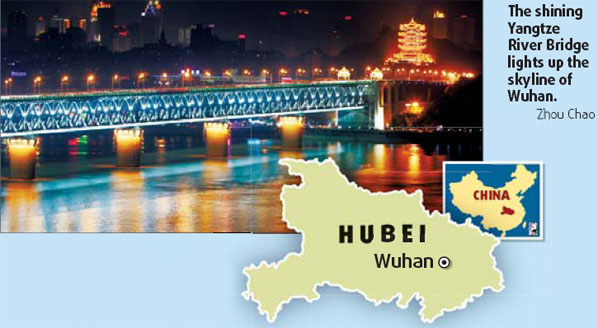|
Sunsets are soothing and the calming view is best enjoyed from the window of a restaurant overlooking the lake. I tried the "Coming Back Fish", one of Mao Zedong's favorite dishes. The white-colored, freshwater fish gets its name because it follows the cruise boats up to the mouth of the Yangtze near Shanghai, then comes back to Wuhan.
Another favorite local dish is re gan mian or hot dry noodles. The locals enjoy this 4-yuan staple meal for breakfast, however I ate it for lunch and dinner too. A special bean paste gives it a tangy taste. Try Wuhan's famous duck necks too.
For shoppers, Hanzheng Street and the bustling walking street near Hanjiang Road are filled with the latest big-name stores, especially sports clothing outlets. There are running shoes galore, possibly reflecting a city with a spring in its step.
Wuhan has a magnetic mix of old and new and in 1911, the locals started a revolution, which shaped the course of Chinese history. A visit to the old Hubei Military Academy reveals where a new, emperor-free China was declared after Sun Yat-sen's supporters gained victory over the Qing soldiers in the Wuchang Uprising.
A plaque reads: "The feudal monarchy which had lasted for more than 2,000 years ended which opened the gate for China to advance."
From these immaculately-kept army barracks, visitors can look up to a nearby hillside and see another military monument, which has become a national icon. The Yellow Crane Tower was built by Sun Quan in AD 223 during the Three Kingdoms (AD 220-280) and enjoys sweeping views over the river. After hundreds of years, its function as an army watchtower changed into a beacon for great minds and thinkers.
During the Tang Dynasty (AD 618-907), it inspired many classic poems and Yellow Crane Tower established Cui Hao as one of the premier poets of the Tang Dynasty.
The poem is still recited in Chinese schools today.
The tower's guidebook says another famous poet, Li Bai, climbed the tower aiming to write one of his masterpieces, but left without composing one character because he felt so humbled by Cui's poem, which was inscribed on the tower's wall.
The power of the poem is lost when translated in English but in Chinese, the rhythm, rhyme and imagery set a new poetic standard for generations.
Like the tones in Cui's poem, the Yellow Crane Tower has had its ups and downs. During the Ming (1368-1644) and Qing (1644-1911) dynasties alone, the tower was destroyed and rebuilt seven times. In 1884, it was once again burnt to the ground and was not rebuilt until 1981. Today it is Wuhan's most famous tourist site.
Nightlife is also growing and much of the nocturnal activity buzzes on the banks of the Yangtze. Dozens of bars and clubs have sprung up over the past five years.
The Hot and Crazy Sugar Daddy Coffee Shop is a small bar run by a lively fellow who says his Chinese name is Cool Sugar Daddy and his English name is Yellow Sausage. Sugar was a tea trader but swapped corporate life to open a bar. "Wuhan has everything a traveler wants to see in China - great food, a busy nightlife, culture and history, one of China's best universities, temples, rivers and lakes," Sugar says. "But most importantly it has great people as sweet as me," he laughs.

|